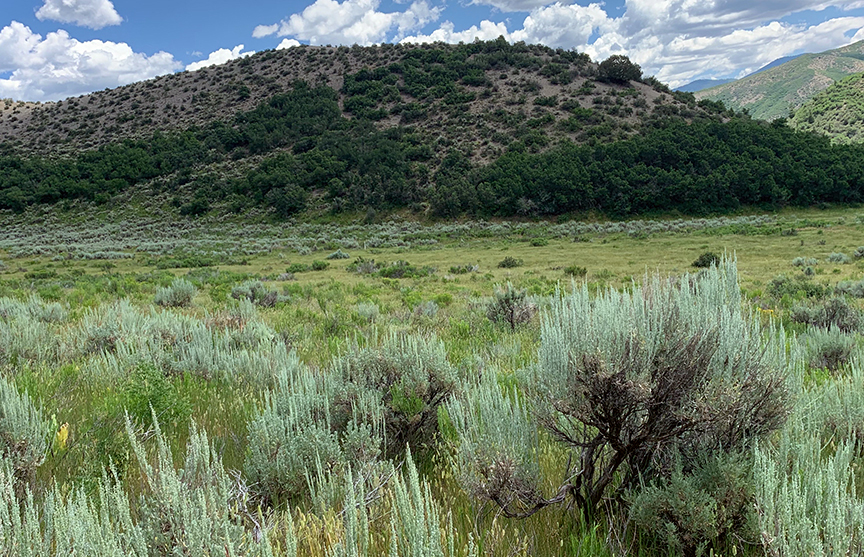Sagebrush shrublands - an iconic, but threatened ecosystem

You know the gray-green leaves, you know the pungent smell on a warm summer day, but did you know that sagebrush is more closely related to tarragon than the sage we use to spice our food?
The distinct smell of sagebrush, an iconic plant in the American West and important to many Native American tribes, comes from chemical compounds that are thought to help protect the plants from herbivory (being eaten). Sagebrush uses a dual root system of deep taproots and wide, shallow roots to access water and act as “nurse” plants, creating microclimates for a native grass and forb understory, habitat for insects and spiders, and cover for birds and small mammals. The evergreen nature of sagebrush means that it plays an important role as wintertime forage for elk and mule deer, though in the summer these species prefer the more nutrient-rich, herbaceous understory. The plants and animals of the sagebrush shrublands are highly adapted to live in concert with each other and support a robust, functioning ecosystem in the arid West.
The National Audubon Society estimates that only about half of the historical extent of sagebrush shrublands remain intact, citing urban development, agriculture, heavy grazing and energy development for the majority of this loss. [1] Locally, big mountain sagebrush shrublands once dominated many of the flat areas and benches in the valley. These same areas have been prime targets for land conversion over the last century.
Land-use conversion to agriculture took out huge swaths of sagebrush, with early ranchers dragging chains across the landscape to take out the twisted, woody trunks of sagebrush. The cleared land was then turned into pasture, rangeland or cropland. Since then, residential, commercial and infrastructure development has continued to contribute to the loss of this habitat type locally. Some animals that rely extensively on sagebrush including sage-grouse, sage sparrows, and jackrabbits are no longer found in the Roaring Fork Valley due to habitat loss. [2]
What’s next for sagebrush?
When the ground surface in a sagebrush shrubland is disturbed, nonnative annual grasses like cheatgrass, medusahead, smooth brome or crested wheatgrass can invade and take over the understory. These annual grasses act as a fuel source for wildfire in an ecosystem not adapted to fire.
Once areas of sagebrush are cleared, whether from fire or land-use change, recovery is slow. Even with diligent management to promote favorable conditions and eliminate competition from nonnative plants, recovery can take over 25 years. [3] Sagebrush is wind pollinated, seed dispersal is minimal (about 10 feet from a mature plant), and germination occurs only under specific environmental conditions. Even after germination, young sagebrush plants are susceptible to grazing from small mammals and competition from faster-growing, nonnative grass species. Often, cleared sagebrush shrubland gets replaced with an entirely different plant community.
Sagebrush restoration and protection efforts by OST
Moore Open Space, located at the entrance to Aspen, holds some of the last remaining sagebrush habitat in the upper Roaring Fork valley. This property is uniquely situated to act as a wildlife corridor, connecting the Maroon Creek Valley to Castle Creek and the main Roaring Fork watershed. It provides a home for the many birds that utilize this Western landscape, including the Brewer’s sparrow – a sagebrush-dependent species identified as a Tier 1 Species of Greatest Concern by Colorado Parks and Wildlife. Open Space and Trails is updating the management plan for this area in 2019, and will include protection of this intact sagebrush habitat.
Along Brush Creek Road, one can see distinct examples of intact versus degraded sagebrush habitat on opposite sides of the road. The Seven Star Trail area, extending from the north side of the road up to the ridgetop, contains intact sagebrush shrublands. Some of this area is characterized by big mountain sagebrush with an understory of nonnative grasses, while the higher areas reflect an even more intact native plant community – one in “possibly the best shape of any in the Brush Creek Watershed.” [4]
On the south side of the road, at the base of Sky Mountain Park, is an abandoned hayfield that is nearly devoid of any shrubs and habitat complexity. This is a prime example of how cleared sagebrush shrublands are replaced by a completely different, predominantly nonnative, plant community. The old hayfield is now the target of sagebrush research and restoration efforts. Pitkin County Open Space and Trails is currently designing plots that will test various restoration techniques on the site in order to inform future sagebrush restoration efforts in the area. A critical part of sagebrush shrubland restoration is also restoring the native herbaceous understory, which provides nutritious forage for various wildlife species. Stay tuned to learn more about OST’s efforts to enhance the ecological system and wildlife habitat by promoting native vegetation.
[1] https://rockies.audubon.org/sagebrush/about
[2] Colorado Wildlife Sciences, Wildlife Biologist Jonathan Lowsky, personal communication.
[3] Innes, Robin J. 2017. Artemisia tridentata subsp. vaseyana, mountain big sagebrush. In: Fire Effects Information System, [Online]. U.S. Department of Agriculture, Forest Service, Rocky Mountain Research Station, Missoula Fire Sciences Laboratory (Producer). Available: https://www.fs.fed.us/database/feis/plants/shrub/arttriv/all.html [2019, July 18].
[4] Tasker, Lisa. Seven Star Vegetation Report, 2006.
By Pitkin County Open Space and Trails
